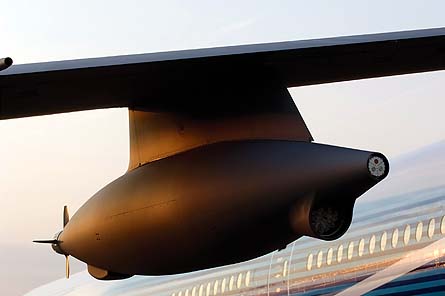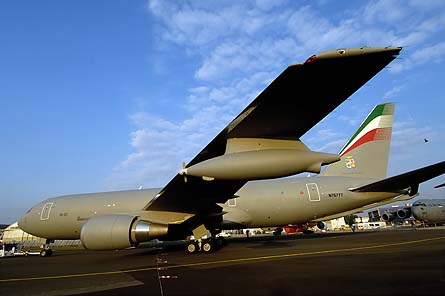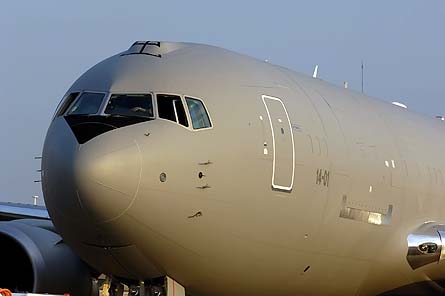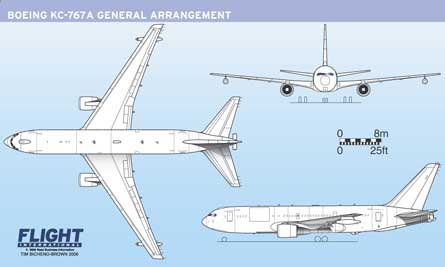By Guy Norris in Wichita
High over the US heartland this summer the first Boeing KC-767A tanker is due to undergo intensive flight tests, the crew checking the stability of the fly-by-wire refuelling boom, and centreline and wing-mounted hose-and-drogue units, as well as preparing for the first boom contact trials later this year.
| The fly-by-wire refuelling boom is operated via joystick from the front of the aircraft |
It is a sight some at Boeing have dreamed of since 1991, when the concept of a 767-based aerial refuelling tanker was first mooted. That year saw the final deliveries from the 707 production line and with it the symbolic dismantling of the cradle that produced hundreds of KC-135s. But it was not until February 1995 that Boeing officially announced the 767 tanker/transport, spurred on by interest from Japan, which earlier selected the twinjet as the basis for its airborne warning and control system.
Boeing put a permanent team in place to begin early development of what was to become the KC-767A tanker/transport in 1999. Launched by an Italian air force order for four aircraft in October 2002, and bolstered by a long-anticipated order from Japan the following March, the first aircraft rolled out in February 2005. Now, with flight tests near the halfway mark, the company is keenly aware the high-profile programme is under the microscope.
The performance of the tanker and the Boeing team in general is under scrutiny as first deliveries approach, while other potential operators, not least the US Air Force, are watching progress with interest. But for the moment Boeing’s Global Tanker development team is focused on completing flight tests of what it believes to be the most advanced tanker available in the most cost-effective and low-risk way possible.
The task is a formidable one. Not only is Boeing developing, flight testing and certificating both the Italian multi-point, multi-role tanker and Japanese boom-only tanker/transport variants simultaneously, but it is executing the most complex modification it has ever attempted on the 767. To cap it all, the aircraft is the first -200ER variant to undergo conversion into a convertible combi (for Italy) and convertible freighter (as the KC-767J for Japan).
Italy’s first aircraft flew from Boeing’s 767 assembly line in Everett, Washington to the company’s Integrated Defense Systems site in Wichita, Kansas in July 2003. Conversion work began in mid-September that year and first flight took place in May 2005, marking the start of a flight-test programme that to date has amassed more than 296h over 81 flights.
But a bland catalogue of milestones belies the astonishing structural transformation that is involved in converting the basic 767 airliner into the KC-767. “The first step is to start taking the aircraft apart,” says 767 tanker production operations director Brad Gorsuch, who likens the process to being “a bit like building a ship in a bottle because you’re dealing with what you already have”. The aircraft is first set up on a “jig jack” for the conversion, a combination of a standard set of jacks and a production-style jig support. “This takes the residual stress out of the aircraft to take out the curvature that you normally get when any long aircraft sits on its own wheels. The jig jack puts the aircraft in a production attitude, which is vital,” he adds. “The one thing you make darned sure you do right is jack the aircraft. We do an optical shoot of the aircraft every week to make sure it’s okay, and hasn’t shifted.”
Once on its jacks, the vertical tail and horizontal stabiliser are removed, and the lower-fuselage Section 48 is detached for replacement with a custom-made Section 48 that supports the ventrally located refuelling boom, centreline hose drum unit (HDU) and its related situational-awareness camera system and fairing.
Everything installed
On the first aircraft the trailing-edge flaps were also removed and replaced with the strengthened 767-400ER flaps. “From now on the aircraft will come from Everett with these already installed,” says Gorsuch, who says the strengthened units are more suited to the higher take-off and landing speeds of the tanker. The inboard flap sections of all aircraft will be detached to allow the removal of a half-skin panel, measuring around 3 x 3m (10 x 10ft). A replacement panel, incorporating an egress door, is cut into Section 46 on the right-hand side.
| Curing wing pod vibration delayed testing |
“This is where we cut in the egress door, and replace the section with a -300 skin panel and Type 1 door for the combi configuration,” says Gorsuch. The door provides an exit for the 100 passengers who will be seated aft of the smoke barrier mounted mid-aircraft when it is in combi mode. This door is not installed in the Japanese conversion, which does not require the additional aft exit. The Italian aircraft is being configured to take 19 military 463L pallets or 200 passengers, or 10 pallets and 100 passengers in combi mode. The standard passenger/freighter conversion KC-767J retains main deck space for 19 pallets or 200 passengers.
The Section 46 door modification is virtually complete before the work starts on opening two more holes on the left side, including an identical egress door and panel by the trailing edge and a much larger cut-out for the cargo door in Section 43 on the forward left-hand side of the fuselage. “It’s a huge hole – mammoth – and it covers almost two-thirds of the circumference of the fuselage,” Gorsuch says. The cut is made at the production break/skin lap-joint on the far side of the crown, where the structure is already strengthened. “When we open up the forward door we don’t leave it cut open for long. There is only a short window of the month where the aircraft is all torn up,” he says.
The original floor beams and rigid floor coverings are, meanwhile, removed, and the specially made strengthened floor grid structure is installed. The grids are built up in Wichita in two sections, forward and aft, before being split laterally for installation using a patented roller-based loading system. The beams sit across eight longitudinal members that run forward and aft over the lower fuselage Section 45. The members are connected with a structural attachment designed to prevent loads being transferred to and from the wingbox. “The biggest issue you have is that you cannot import loads into the wing box. The engineers get all worked up about this part of the aircraft,” says Gorsuch.
“Now we start the big effort to attach all the hardware, and while we are doing the structural strengthening in the aft, we have the electrical and system people go into the electrical equipment bay to begin attaching racks and harnesses, and make other system changes.” This includes the addition of extra heavy-duty fuel pumps to supplement the 767’s standard complement of fuel-transfer system pumps. These are required to handle the 3,410 litres/min (900USgal/min) transfer rate of the boom at 3.45bar (50lb/in2), the centreline HDU at 2,275 litres/min and wing aerial refuelling pods (WARP) at 1,515 litres/min.
Next comes the modification of the Section 41 fuselage crown to accept the universal aerial refuelling receptacle slipway installation (UARRSI), which is capable of taking on more than 3,410 litres/min of fuel from a boom-equipped tanker. “To do this we basically take out the whole flightdeck. It’s just like major surgery. You have to get to the heart of the patient, but the rib cage is in the way,” says Gorsuch.
The fuel line from the UARRSI travels aft overhead the remote aerial refuelling operator (RARO II) station before dropping down through the sidewall below main deck level to feed the main tanks. From here the fuel line passes through lower hold locations for optional auxiliary tanks before running aft to feed the HDU and boom. The aircraft has a maximum fuel capacity of 73,000kg (161,000lb) in its wing and standard centre-wing tanks, with the lower and upper part of the fuselage free for transport duties.
The modification is aimed at retaining the basic structural integrity of the aircraft against “abuse” loads. “We build a box in there and drop the UARSSI into it. Then we replace the circuit-breaker panel, and start in and replace everything we had to take out of the cockpit,” says Gorsuch.
New software standard
One of the new flightdeck systems is a more-capable Smiths Aerospace flight management computer (FMC). Smiths is working with California-based software specialist Wind River to provide a real-time operating system (RTOS) for the FMC. Replacing the standard Honeywell-provided Pegasus FMC, the flight-management software and related operating system will be covered by a supplemental type certificate and be the first to be approved by the US Federal Aviation Administration to the new DO-178B software standard. Like a similar RTOS being adopted for the 787’s common core system, the open system architecture of the KC-767A’s FMC means it will be more easily upgradeable. The system will also be capable of Category 3B automatic landing, but this will require additional flight-test and certification work.
| The Italian air force will receive its four tanker/transports by 2008 |
The jump to the new FMC “was pretty inevitable”, says 767 tanker programmes systems engineering and integration senior manager Doug Garrette. “It had to be able to handle a lot more than the average commercial aircraft computer, including how to do military tracking and rendezvous with other people in mid-air. When you’re playing flying gas stations there’s a lot more hand shaking to be done,” he adds.
The RARO II station is one of the key units installed and goes in forward of the 9g rigid cargo barrier, which is aft of the join between Section 41 and 43. Unlike the KC-135, in which the boom operator lies prone in the aft of the aircraft and manually controls the boom for refuelling, the KC-767A refuelling operator sits at the RARO II station near the front of the aircraft and uses a joystick to manipulate the fly-by-wire (FBW) boom. Using the aerial refuelling operator control and display unit, the operator can view the status of the entire refuelling system and monitor operations through five digital cameras. The situational awareness camera system (SACS) includes a ventrally mounted camera with a view beneath the tail, plus two flush-mounted cameras either side of the fuselage that monitor the wing-mounted hose drogues. A separate set of boom cameras is mounted further aft of the main SACS unit on the fuel manifold fairing.
The RARO II operator wears a head-mounted display to view a high-definition stereoscopic image of the outside world using a remote-vision system. This takes digital imagery from the SACS and processes it through an enhanced vision system that improves the image contrast and reduces spatial distortion. The joystick, or boom flight controller, provides azimuth, elevation and extension/retraction control, while an active feedback system keeps the controller in touch with the movement of the boom itself.
“Operating the RARO is almost like a virtual-reality video game,” says Garrette, who says the entire system, including the RARO, Smiths-developed aerial refuelling control computer (ARCC) and FBW boom, is being run through its paces in the ground-based systems integration laboratory. “We already have all the control laws and when we bring the boom operator into the lab you can see how you have a lot more information at your fingertips. It’s like a porthole into the back of the aircraft.”
Localised structural strengthening work is also required to bolster the outboard wing to support the WARPs, which are also supplied by Smiths. An attachment fitting is added to the spar chord forward and aft, while three ribs are also strengthened, as is the leading edge. The pods, mounted well out towards the wingtips, also provide wing bending relief, says Gorsuch.
To avoid integration hiccups in the fuel- delivery system, Smiths opened a fully automated refuelling test facility at its Corona, California site to test the WARPs and HDU simultaneously. Each wingtip pod is self-powered, while the HDU is integrated with the aircraft power system. Both pods are fitted with hose reels incorporating a microprocessor-based electronic control system to increase the response rate of the hose system. As well as the WARPs, HDU, ARCC and FMC, Smiths also provides the boom actuation control system, electronic elevator feel computers, high-lift actuation, power distribution and the standby instrumentation system.
While systems installation is completed forward, the new Section 48 is offered up to the lower rear fuselage. With reinforced frames and stringers, the revised section houses the centreline HDU, the drum unit’s guide tube and the pressure box that isolates the HDU nozzle exit area from the pressurised fuselage. Aft of the HDU pressure box is the rear pressure bulkhead, which is penetrated close to the lower keel to provide access for the fuel line supplying the boom.
The tailcone is also modified with the addition of a titanium firewall forward of the auxiliary power unit, and structural reinforcement to accept loads from the winch that is installed to retract the boom, plus loads from the boom mounting. The horizontal and vertical stabilisers are also reattached to complete the modification.
| The converted 767's in-flight aerial refuelling receptacle is above the cockpit |
Italy’s three remaining aircraft will be completed by Alenia Aeronautica’s Aeronavali subsidiary in Naples, with additional work to be completed in Wichita. “The second aircraft is going well,” says Italy programme manager Jeff Keller. “We’ve had challenges with parts and paperwork, and we’re hoping to get the aircraft [back in Wichita] this fall, but it will probably move out to the end of the year.” The third KC-767A arrived in Naples in April, and floor-grid assembly has begun. However, Keller says, “major tear-down will probably not start until August”.
The Italian firm is also involved in Boeing’s Japanese and other prospective international tanker programmes, providing the convertible combi or freighter and hose-drum unit modification and installation kits. Although first delivery has been delayed from this year until mid-2007, the Italian air force will receive all four of its aircraft by the end of 2008. The aircraft will replace four 707 tanker/transports assigned to Pratica di Mare air base near Rome.
Schedule shift
The delay is largely down to a buffet problem discovered during flight tests on the wingtip pods. The schedule shift, which will now see the flight-test programme on “Italy One” completed in around a year from now, means that the Japanese Air Self-Defense Force will receive the first KC-767. The initial Japanese tanker, which is configured with a refuelling boom only, is nearing completion and is expected to fly in October for delivery in December.
Boeing says other factors were involved in the decision to slide Italy’s first delivery. The customer has asked “for additional enhancements” involving the avionics and interior, says Keller, who explains the upgrades will be added during the extended stay in Wichita. The unexpected vibration cropped up during flight tests when airflow separation around the pylon connecting the refuelling pod to the wing set up a buffet in the structure. “The vibration was not that severe, and even at the pilot’s seat was less than light turbulence. But it was something commercial pilots hadn’t experienced on the 767, and for safety’s sake we wanted more data,” he says.
A revised pylon shape has been tested in Boeing’s transonic windtunnel in Seattle and subjected to computational fluid-dynamics analysis by both Boeing Commercial Airplanes and its Phantom Works research organisation. The pylon, now slab-sided, has been redesigned to prevent the flow becoming supersonic. “This doesn’t allow it to accelerate,” says Keller, who expects forthcoming flight tests to prove the problem has been solved.
Until recently, flight tests have concentrated on initial airworthiness, initial flutter and cruise performance, says 767 tanker test programme manager Keith Branch. In April the team completed ground vibration testing at the Boeing structural dynamics laboratory in Everett, paving the way for full-up flight tests. “These tests determined the structural interaction between the aircraft and the aerial-refuelling boom, and now we’re one step closer to testing the tanker’s refuelling systems during flight,” says Branch.
Other tests focused on operating the environmental control system (ECS) in three modes: passenger, freighter and combi. “This drives a lot of smoke detection/penetration work, and we think it’s the first 767-200 to do all that,” says Branch. Take-off performance work is due at Edwards AFB shortly. The position of the refuelling boom changes the rotation and ground angles of the KC-767, which necessitates a 10kt (18.5km/h) increase in take-off speed to maintain the same ground clearance as the standard aircraft.
Of roughly 1,000h scheduled test hours due to be racked up on the Italian KC-767A, 30% will be concerned with refuelling, 25% basic aerodynamics and stability testing for the structural changes, 25% for avionics and the balance for ECS-related work, says Branch. Stability testing of the deployed boom, which until recently has always been stowed in flight, is to begin before the end of August, with deployment tests of the HDU and WARPs scheduled for July-September. Boom contact flights, involving receiver aircraft, are planned towards the end of the year. Boeing now expects to deliver the first two tankers to Italy in mid-2007 and the last pair in 2008.
Japan first
The first aircraft for Japan, meanwhile, is nearing completion in Wichita and is to make its first flight in late October. Given the pathfinding role of the Italian aircraft and the simpler configuration of the Japanese aircraft, the KC-767J flight-test effort is expected to require around 100h, most of it focused on the ECS, unique avionics and an encrypted radio package.
The second of four Japanese tankers, meanwhile, entered final body join at Everett in April, and is at Wichita awaiting the start of modification later this year. Aircraft are due to be delivered every December at the rate of one a year until the fourth is handed over at the end of 2009. Japan 767 tanker programme manager John Bade says the effort is on track for a successful flight-test readiness review on 17 July. He is confident of getting more business from Japan in 2008 when it signals its future fleet intentions as part of its next mid-term 2010-15 defence plan.
“They’ve never had a tanker. For the first time they’re working towards becoming a world player, and they see the tanker as part of the way to get there,” says Bade, who adds that the freighter capabilities of the aircraft may form a key element in Japan’s plans to supply humanitarian relief.
In the meantime, Keller believes the Italian and Japan tankers could be pathfinders towards bigger sales both domestically and internationally. “We have an aircraft flying now. The risks are known and we’re wringing out the bugs as we speak. In that way, this is definitely a low-risk solution for anyone’s tanker needs.”
Source: Flight International



























